Grub Damage And Grub Control
Grub Damage And Grub Control
Grub damage is one of the more costly and unsightly damages that can occur on a lawn. White grubs are C-shaped insects with a chestnut colored head and 3 pairs of clearly visible legs. The rear end is slightly larger than the rest of the body. It may appear darker in color due to the soil and organic matter they ingest.
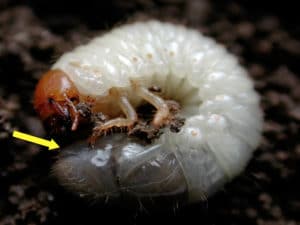
White grubs are actually a variety of beetle larvae in the family Scarabaeidae. They are common pests of not only turf lawns, but also golf courses and farm fields. Often called scarab beetles, the family consists of over 30,000 species world-wide.
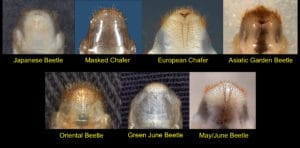
The larvae of several species are common pests of turfgrass. These species include the Japanese Beetle, Masked Chafers, European Chafer, Asiatic Garden Beetle, Oriental Beetle, Green Junebug, May Junebug and Black Ataenius.
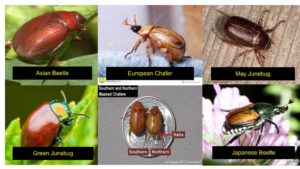
Primary Grub Damage
White grubs are capable of causing serious damage to a lawn. White grubs damage a variety of warm and cool season grasses while feeding on organic matter, thatch and roots. These pests have widespread and overlapping territories. It is not uncommon to find two or more species at a single location.
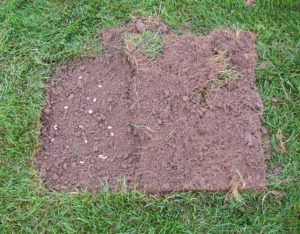
Feeding grubs damage plant roots, causing the turf to wilt and die. Early indicators of grub damage include patchy wilting and stressed turf that does not respond to irrigation. Turf ultimately loses the ability to sustain itself resulting in dead or extremely thin patches. 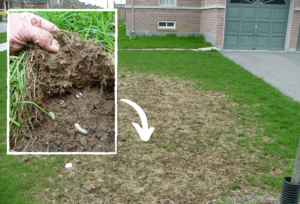
This kind of damage is called primary damage. It may result in sod that easily pulls up or tears away from the soil, revealing the white grubs beneath.
Secondary Grub Damage
Secondary damage from raccoons, skunks, or turkeys foraging for white grubs is also common. Often, it will be the first indication of an infestation. Animals foraging for white grubs can be a serious concern for homeowners. because of the damage caused as they dig for the grubs. Animals such as raccoons, skunks, and turkeys routinely forage for white grubs that infest turfgrass. This can happen even when primary damage from the grubs themselves is not obviously present. Although trapping these animals may provide a long-term solution for homeowners, but such activities can be costly and time consuming. 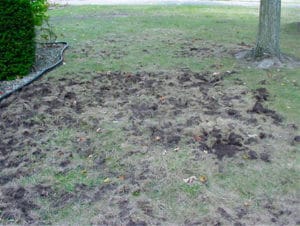
A recent study suggests the use of Milorganite organic fertilizer can deter foraging animals. The application of Milorganite to areas damaged by foraging animals can reduce further damage by 75% or more over the short-term. The long-term effectiveness remains unclear, but reactive use appears to be effective at reducing further damage over the short-term.
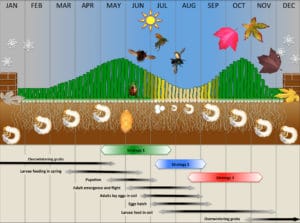
Annual White Grubs
Annual white grubs are the most common pest species. They produce one generation every year. Several annual white grubs species are considered exotic, invasive species, but others are native to North America. These species survive the winter in the larval stage, pupating in the soil during late spring or early summer. Adults emerge and fly during early to mid summer and begin laying eggs in the soil. The adults of some species can be serious pests of ornamental plants during this time.
Eggs hatch by the end of July. They produce small larvae that begin feeding in the root zone. Large larvae are present by September. Damage may appear anytime between August and November. Later, the larvae move deeper down into the soil to spend the winter. Larvae move back up into the root zone to feed again in the spring. Damage to turf may also occur during this time.
Common Midwest Annual Grubs
Although European chafer is capable of causing damage at lower densities, other species such as Japanese beetle, Asiatic garden beetle and black Ataeneus usually require higher densities to cause visible damage.
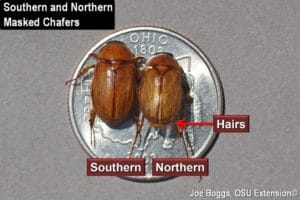
Because of the burrowing and mounding activity of green June beetle larvae, unacceptable levels of damage may occur at even lower densities. The grubs will grow to about 40 mm (1.6 in) and are white with a brownish-black head. The larvae will molt twice before winter. The fully grown larva is glassy yellow/white shading toward green or blue at the head and tail. The larva has stiff bristles on its abdomen which assist movement. The larva normally travels on its back. The underground speed is considered more rapid than any other grubs and is comparable to that of the hairy caterpillar. The larvae feed on humus and mold but also do considerable damage to root systems. The larvae are considered pests when they cause damage to lawns or turf grasses. The adults begin to appear in June. The color varies from dull brown with green stripes to a uniform metallic green. The adult beetle will feed upon a variety of fruits and are particularly attracted to rotting fruit.
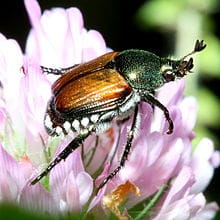
The Japanese beetle is a species of scarab beetle. While the larvae of Japanese beetles feed on the roots of grasses, the adults consume the leaves of a much wider variety. It is not very destructive in Japan, where it is controlled by natural predators, but in North America, it is a noted pest of about 300 species of plants including rose bushes, grapes, hops, canna, crape myrtles, birch trees, linden trees, and others including common crops such as strawberry, tomato, pepper, grape, rose, cherry, plum, pear, peach, raspberry, blackberry, corn, pea, okra, and blueberry.
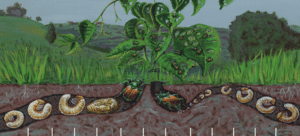
The adult beetles will damage plants by skeletonizing the foliage. They only eat the leaf material between the veins. It may also feed on fruit on the plants. The larvae feed on the roots of grasses. The adult has iridescent copper-colored wing and a green thorax and head.
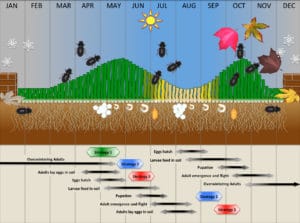
Semi Annual Grubs
The Black Ateanius produces two generations of larvae each year. It is the primary species of semi-annual white grub affecting turfgrass in the Midwest. Adults are small black beetles that survive the winter in the thatch and soil. Adults migrate from overwintering areas during spring and begin laying eggs. Eggs are laid in the soil in small clusters that typically hatch by late May. First generation larvae feed until mid-July. Grub damage may be visible by late June. These larvae pupate producing new adults by early August. These adults typically lay eggs producing a second generation of grubs by mid-August. Damage from this second generation is not uncommon. Second generation larvae pupate by September and emerging adults usually leave the fairways for overwintering sites by October. This species is not known to damage lawns, but is capable of causing serious damage to closely mowed golf course turf.
Chemical Control
This strategy targets early white grubs in areas where populations are high enough to be a concern, but before damage is visible. Any registered white grub insecticide is appropriate for this approach. Neonicotinoids are typically the best for prevention. Proyducts like Dylox are used as curatives after damage has already been seen. Monitoring white grub populations in the soil is a cornerstone of this strategy. The goal is to prevent damage while avoiding unnecessary applications.
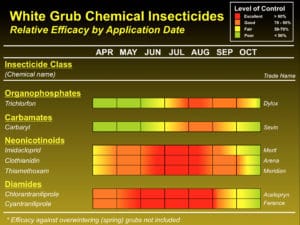
Repairing Grub Damage
Whether it is primary damage from feeding grubs or secondary damage from animals feasting on the grubs under the turf, the damage will not repair itself. It can be lasting and very unsightly. The best option for repairing grub damage, once the grubs have been eliminated from the lawn, is to do a double pass core aeration and overseeding. If damage is so significant that aeration and overseeding isn’t enough, then slice seeding is the next option. Both options will repair the damage to the turf, but only a lawncare program with a grub prevention application will keep damage from recurring in the future.
If you are looking for expert lawncare help, feel free to call our office at 317-748-3153. Or visit us online at www.GreensLCPS.com. Or click HERE to request an estimate.